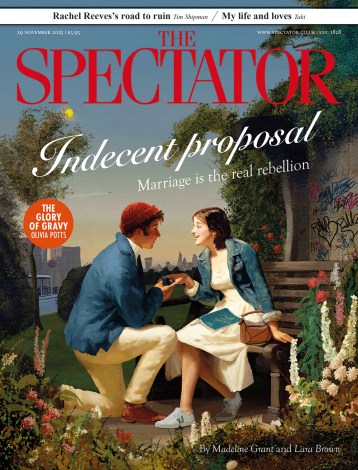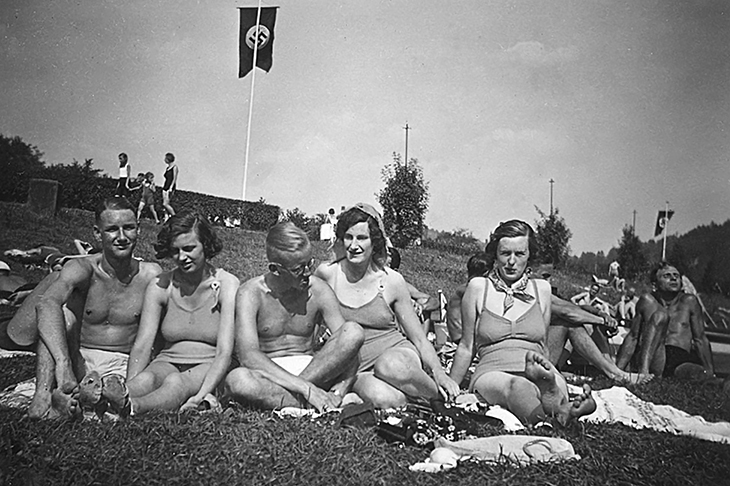Novelists’ careers take different paths, and sometimes don’t look much like careers at all. It’s true that some start publishing between 25 and 35, and write a novel respectably every two or three years until they die, like Kingsley Amis. Others don’t start until they are 60, like Penelope Fitzgerald, or stop abruptly without warning, like Henry Green, or write one novel and no more, like Harper Lee. Inspiration, or interest, comes and goes, and both the audience and the industry will have their wilful way with creativity. The ultimate aim of a novel, to be read with pleasure decades after its creator’s death, is reached in tortuous ways. Who in the 1960s would have thought that by the 21st century one of the most admired American novelists would be John Edward Williams, the author of Stoner — or put money on Barbara Pym having any claim on posterity?
A cup of tea is poured; a character wonders ‘why Father Ransome couldn’t live at the clergy house’; a spinster chooses a rather too daring shade of lipstick for herself (‘Thank you, but I think I will have Hawaiian Fire’); love is shyly offered, and not returned. Pym’s world is very strongly her own, with as particular a flavour as E.F. Benson’s Tilling, or P.G.Wodehouse’s Blandings. We think we know what to expect. But then things take an unforeseen turn. A young woman in 1955 is living with her boyfriend; a handsome man in 1958 is unavailable because of the prior claims of a model called Keith; an elderly woman starves to death; suburban life is analysed according to anthropological principles; characters in Kensington believe that the birds of the city are plotting to kill them (‘She handed me a cutting headed OWL BITES WOMAN’).
The territory is unique and unmistakable, and a real aficionado can recognise the author from a page, or even a sentence. (‘I foresaw the surprising card that might accompany the flowers: “With love and deepest sympathy from Wilmet and Rodney Forsyth and Wilfred J. Bason.”’) They are more than idiosyncratic, however; they have a real technical mastery. A Glass of Blessings, in particular, is a little marvel of skill; a proper social panorama, with 77 named characters, but told in the first person. The miracle is the naturalness with which Wilmet moves through different worlds — Wolfenden gays, church, cocktail parties. When you read this, or the splendid Excellent Women, next to more celebrated novelists of the early 1950s, such as Pamela Hansford Johnson, it is hard to see how such ability and observation could be overlooked.
Pym visited Nazi Germany a number of times and had a boyfriend who was an SS officer
The professional life, however, as told in Paula Byrne’s illuminating biography, was largely one of indifference, neglect and a long, painful period of exclusion. Pym wrote prolifically from a very young age, but her debut, Some Tame Gazelle, first drafted in 1934, didn’t find a publisher until 1950. Most cruelly, her long-standing publisher, Jonathan Cape, refused her seventh novel, An Unsuitable Attachment, in 1960. She remained unpublished until Philip Larkin and Lord David Cecil independently nominated her in 1977, for a feature in the TLS, as the most underrated writer of the century. TLS pieces evidently had more impact then than now; she was very happily
rediscovered and feted in the three years before she died. The novels she wrote in exile, as it were, were published and widely acclaimed — especially Quartet in Autumn and the heartbreaking The Sweet Dove Died — as incisive, even bleak masterpieces.
The hardships of Pym’s career were genuine, and not to be wished on anyone, but I wonder whether, ultimately, they contributed to the quality of the body of work. Jonathan Cape behaved abominably in dropping her without any discussion when none of her novels had ever lost money, but there is no doubt that An Unsuitable Attachment is one of her weakest novels. The rejection, and the consequent desperate state of mind, led Pym to a hopeless, unrequited love affair with a charming but unreliable Bahamian homosexual, Richard ‘Skipper’ Roberts. The novel that experience inspired, The Sweet Dove Died, might be her best — written in the pain of multiple rejections, romantic and professional. It is utterly truthful, born from the suspicion that perhaps only a dozen intimate friends would ever read it.
Less known is the real luck Pym might have had in coming late to publication. Byrne has unearthed the genuinely alarming information that Pym, in the 1930s, was a reasonably committed supporter of Nazism. She visited Nazi Germany a number of times, had a boyfriend called Friedbert Glück, an SS officer, and met and talked to Julius Streicher. If Jonathan Cape had accepted the first version of Some Tame Gazelle and published it in 1936 they would have brought out a novel, set some way in the future, in which Belinda, who knits socks for the ‘poor Nazis’, reflects ‘how delightful it would be to see if she could still speak German! How she would enjoy remembering with them their lamented Führer’, and regrets ‘the terrible revolution of the 1950s and all the dear Nazis in exile in Africa…’ This version, preserved in manuscript in the Bodleian, might have been enough to stop Pym’s career in its tracks.
Other writers are currently being cancelled for much less. Byrne, herself a novelist, captures the long, muddled journey of this life beautifully. A previous biography, Hazel Holt’s, was written by a loyal friend and, though still worth reading, smooths over some spiky corners. (It was with Holt, however, a colleague working at the International African Institute, that Pym constructed a version of a ‘juju’, containing magical objects to which sacrificial offerings were made when wayward contributors were late with copy for the Institute’s magazine.) Byrne sees what fun Pym was, how much she liked and was fascinated by people, but also the sheer oddity of her character, and the hair-raising scrapes her novelist’s curiosity led her into.
One of the most startling of these, toned down and retold in No Fond Return of Love, was Pym’s interest in her neighbours in Barnes in the mid 1950s. They were two homosexual men. Pym had been fascinated by gay men since Oxford, when she formed a lifelong friendship with the novelist Robert Liddell. Her Barnes neighbours were nicknamed by Pym and her sister Hilary ‘Bear’ and ‘Squirrel’. One was glimpsed in a cassock; the Pym sisters, in a hired car, followed him to a church in Kilburn, where he proved to be the organist. (It’s quite surprising that nobody seems to have noticed Barbara at least, with her striking resemblance to Joyce Grenfell.) Mysteriously,
a new young man moved in, then a fourth. (‘Hilary and I saw him coming from the bus stop about 10.30 last night…Tony is still in residence with masses of peculiar-looking friends.’) Friends were involved, and tracked all the gays, quite unaware of their stalkers, to church, Heal’s, a florists in Shepherd’s Bush ‘and once even to a private hotel in the West Country’. Novelists are generally quite curious people, but Pym’s energy in investigating these strangers’ lives goes a long way towards criminal behaviour. Worthwhile, though.
Pym hardly needs rediscovery. Her books are in print, admired by a substantial coterie, and have the tolerant investigation of a specific time and place that never really dates. Byrne has done us a great service by going beyond the defensiveness that many previous writers on Pym have understandably felt necessary, and exploring this very unusual personality. She avoids, too, the danger that many writers on idiosyncratic novelists fall into, of not examining their place in the wider literary ecology.
Pym’s place was a delicate one: she was intimate friends with that very sophisticated novelist Robert Liddell, who is given proper respect here, but for some reason was not hoffähig enough to be introduced to Liddell’s great patron and her own literary idol, Ivy Compton-Burnett. She did meet Elizabeth Taylor, but the friendship didn’t prosper. For the most part, she seems to have been just as happy with perfectly ordinary people. There was also her lovely though remote friendship with Larkin, which Byrne recounts for the first time with a proper sense of two funny, clever, slightly angry people enjoying each other’s minds. It was a friendship that saved her, with Larkin’s advocacy at the height of his fame, and which does a good deal to redeem him.
Probably Pym, even at the fairy-tale ending of her life, hardly expected to be given such honourable treatment by posterity, and by such a well-equipped and sympathetic biographer. This, like its subject’s best books, rewards reading and re-reading.






Comments